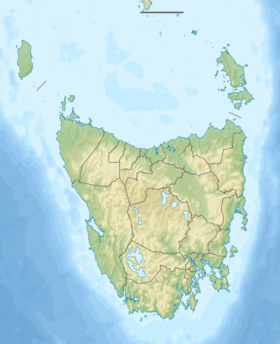Cape Bruny Lighthouse
 Cape Bruny Lighthouse Tasmania | |
| Location |
Bruny Island Tasmania Australia |
|---|---|
| Coordinates | 43°29′28.1″S 147°08′32.0″E / 43.491139°S 147.142222°ECoordinates: 43°29′28.1″S 147°08′32.0″E / 43.491139°S 147.142222°E |
| Year first constructed | 1838 (first) |
| Year first lit | 1996 (current) |
| Automated | 1996 |
| Deactivated | 1996 (first) |
| Construction |
rubble masonry tower (first) fiberglass tower (current) |
| Tower shape | conical frustum tower with double balcony and lantern (first) |
| Markings / pattern | white tower and lantern |
| Height |
13 metres (43 ft) (first) 5 metres (16 ft) (current) |
| Focal height |
93 metres (305 ft) (first) 105 metres (344 ft) (current) |
| Light source |
diesel engine (first) solar power (current) |
| Intensity | 1,400,000 cd (current) |
| Range | 26 nautical miles (48 km; 30 mi) (current) |
| Characteristic | Fl W 10s. (current)[1] |
| Admiralty number | K3654 |
| NGA number | 6868 |
| ARLHS number | AUS-024 |
| Managing agent | South Bruny National Park |
The Cape Bruny Lighthouse is an inactive lighthouse located at the southern tip of Bruny Island, Tasmania, Australia.
Features and location
It is the second oldest extant lighthouse tower in Australia, as well as having the longest (158 years) history of being continuously manned. It was first lit in March 1838 and was eventually decommissioned on 6 August 1996.[2]
The project was commissioned by Governor George Arthur in 1835 after a series of shipwrecks south of Bruny Island and construction began in April 1836. The lighthouse was built by convict labour using locally quarried dolerite over two years. When first lit in March 1838 it was Tasmania's third lighthouse and Australia's fourth.[3]
Cape Bruny was initially illuminated by a Wilkins lantern, consuming one pint of sperm whale oil per hour. In 1892, sperm oil was replaced by the better quality colza oil. In 1903 the original staircase was replaced and a cast-iron staircase was installed and the Wilkins lantern was replaced with a Chance Brothers lantern, which both remain in the tower today.[3]
In December 2000 the light station area, including the lighthouse, became part of the South Bruny National Park.[4] The lightstation was maintained by a permanent caretaker until 2011 when the Parks & Wildlife established a rotational volunteer caretaker program. Volunteers live on-site in the caretakers cottage for four-week periods, assisting with repairs and general maintenance.[5]
In June 2012, the Tasmanian Government sought expressions of interest from commercial operators wishing to take over the operation and management of the Cape Bruny Light Station. No tender was awarded[6] and the site is managed by the Parks & Wildlife Service with assistance from volunteers. Following the tender process, only one company began tours of the South Bruny National Park and Cape Bruny Light Station that takes tourists to visit the Cape Bruny Lightstation - Bruny Island Safaris The latter, Bruny Island Safaris, also operates tours inside the lighthouse tower.
An active light tower is located nearby on a fiberglass construction of 4 metres (13 ft) height. Its light characteristic is "Fl. 10 s", i.e. a white flash every 15 seconds. The lightsource emits from a focal plane at 93 metres (305 ft) above sea level.[7]
See also
References
- ↑ Cape Bruny Lighthouse Lighthouses of Australia Inc.
- ↑ Tasmanian Parks & Wildlife Service. "Cape Bruny Lighthouse". Retrieved 17 March 2013.
- 1 2 Lighthouses of Australia Inc. "Cape Bruny Lighthouse". Archived from the original on 18 March 2013. Retrieved 17 March 2013.
- ↑ Parks & Wildlife Service, Tasmania. "Guide to Tasmania's Historic Places - Cape Bruny Lighthouse". Retrieved 29 November 2007.
- ↑ "The light on Bruny Island's Cape". Australian Broadcasting Corporation. Retrieved 17 March 2013.
- ↑ Tasmanian Government Tenders. "Expressions of Interest - Cape Bruny Light Station - South Bruny National Park". Retrieved 17 March 2013.
- ↑ Rowlett, Russ. "Lighthouses of Australia: Tasmania". The Lighthouse Directory. University of North Carolina at Chapel Hill. Retrieved 21 July 2008.
External links
- Australian Maritime Safety Authority
- Cape Bruny Lighthouse Information - Lighthouses of Australia Inc
- Cape Bruny Lighthouse Information - Parks & Wildlife Service
- Bruny Island Lighthouse Tours